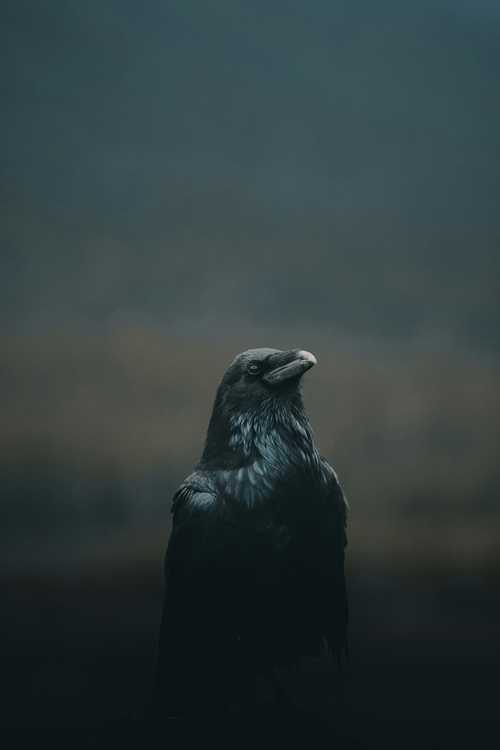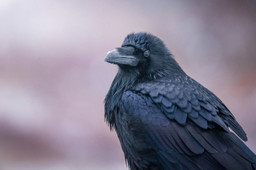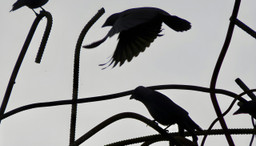
The short answer is: yes. But let’s dig into how this ability derives from crows’ considerable intelligence.
So, what exactly are we talking about when we say that crows are intelligent?
More specifically, we’re talking about the crow family – the Corvidae family, in taxonomic terms; or, colloquially, corvids. These 139 species include:
- Around 46 species of crows, ravens, and rooks (the Corvus genus)
- Twenty New World jays
- Assorted jackdaws, choughs, nutcrackers, Southeast Asian treepies, and magpies (excepting Australian magpies, which, despite their name, are from a different family).
And as for intelligence: the ratio of brain size to body size (AKA encephalization level) is thought to correspond to intelligence. Corvids’ encephalization level is not only higher than in other birds (except for the 12 species of psittacid parrots), but similar to that of apes.
Corvids’ intelligence is attributed to various factors, such as:
- Living, often, in large family groups, which enables and necessitates the management of high social complexity
- Their predominantly omnivorous diets, which drive exposure to a range of environments and circumstances
- A long growing period spent with parents, maximizing opportunities for skills to be passed on
- The severity of the environments in which they frequently live, where intelligence is a prerequisite for survival
- Brains which, in spite of their small size, are packed with more neurons (cells that send and receive messages between the body and the brain) than are found in the brains of mammals.
Observations of corvid intelligence
- Social games played by corvid young – including ‘follow the leader’ or ‘king of the hill’, and play involving, for example, “the manipulation, passing, and balancing of sticks” – underpins their capacity for adaptation and survival. (An example of such “unrewarded object exploration” can be seen in a video of a crow improvising using a jamjar lid to repeatedly sled down a snowy roof)
- In the wild, New Caledonian crows “whittle branches into hooks and tear leaves into barbed probes” to draw insects or larvae out of tree bark, while “experiments have shown that the birds can [also] craft new tools out of unfamiliar materials”, and use different tools sequentially (which represents a higher cognitive function than the use of a single tool)
- A meta-analysis of feeding “innovations” observed in the wild (as reported in published ornithology journals over 75 years) placed Corvidae species at the top of the scale of “avian IQ”
- Outperforming both cats or dogs in an experiment involving hidden bait, designed to assess understanding of the “dimensions of objects”
- A 2004 review which suggested intelligence equivalent to that of the non-human great apes (orangutans, gorillas, chimpanzees, and bonobos) – a demonstration of “complex cognitive abilities evolv[ing] multiple times in distantly related species with vastly different brain structures”
- Magpies, ravens, and crows have been observed taking part in grieving rituals for dead individuals, including laying grass by a corpse
- The use of declarative gestures to “co-ordinate attention towards a social partner and an object of mutual interest” – behaviour previously only observed in great apes
- Crows can understand analogies (solving analogical reasoning puzzles it was also previously thought only great apes could understand)
- Communication via a wide range of vocalizations; common ravens, for example, have been recorded using between 15 and 33 categories of vocalizations
- In both American and Japanese cities, crows drop nuts onto busy streets at traffic lights, before waiting for the lights to change and safely collecting the nuts cracked open by cars’ tyres
- After fighting, “crows […] touch and preen each other to make up”, or “s[eek] consolation from others with whom they didn’t fight”
- In a test involving water displacement, “crows performed on a level that […] only seven- to 10-year-old children have been able to complete successfully”.

All of this is to say that, via convergent evolution (unrelated species independently developing similar characteristics), corvids share some of the same plasticity and problem-solving abilities as primates, enabling them to be similarly skillful at “adapt[ing] and chang[ing] in the face of new information and experiences”.
Recognition of dangerous humans
Is it then surprising to imagine that crows can, indeed, hold grudges? In fact, they possess an ability not only to recognize human faces, but to pass on information about specific humans who have got themselves into the crows’ bad books.
In 2011, University of Washington researchers trapped, banded, and released multiple crows at a range of sites in the vicinity of Seattle. Crucially, while doing so, they wore identical masks (showing the face of a caveman). Over the following five years, observations were made of crows’ responses to people walking a particular route while wearing these same caveman masks, which marked them out as humans to be wary of.
For two weeks after trapping, 26% of crows that encountered the mask-wearers “scolded” them: directing a repeated ‘kaw’ alarm call in their direction, along with wing- and tail-flicking. After 15 months, the number of crows responding to the masks in this way had increased to 30%. Three years later, during which no further action had been taken against the birds, the number had swelled to 66% – clearly indicating that the threat from the ‘caveman’ had been “passed on between peers and from parent to child”.
Six more realistic masks (including male, female, Caucasian, and Asian faces) were also used, yet the crows remained “very, very good” at identifying individuals which had been identified as dangerous. “Learn[ing] which […] animals are dangerous without having to face the danger” confers clear benefits for survival; recognizing and sharing danger in this way is particularly advantageous for synanthropic species like crows – which readily adapt to living alongside humans – and given that human actions so frequently threaten animals.
Many cultural associations with corvids depict them as sinister or foreboding, yet it would be fairer to see their intelligence in terms of admiration. Perhaps increased understanding of their intelligence will encourage us to treat them – and other species – more humanely.

Corvid recordings on Earth.fm
- ‘A Mysterious Dusk in the Ravines’ (including red-billed chough)
- ‘Black Kites at Tianchi Lake’ (including northern nutcracker)
- ‘Cave Entrance in the Balkans’ (including raven)
- ‘Coyote in the Moonlight’ (including Clark’s nutcracker)
- ‘Dawn at Rowallan Dam’ (including Tasmanian forest raven)
- ‘Dawn Chorus at the Spittal of Glenshee’ (including rook and western jackdaw)
- ‘Dawn Chorus in Rusava, Solisko’ (including Eurasian jay)
- ‘Dawn Chorus in Sequoia National Forest’ (including raven)
- ‘Dawn Chorus in the Forest of Brou’ (including crow and Eurasian jay)
- ‘Dawn Chorus Near Rijeka’ (including Eurasian jay)
- ‘Dawn in County Wicklow’ (including rook)
- ‘Dawn in Late Autumn with Corellas’ (including Australian raven)
- ‘Dawn in a Swedish Island’ (including magpie and hooded crow)
- ‘Forest of Life’ (including rufous treepie)
- ‘Forest Reflections’ (including raven)
- ‘Heart of the Rainforest’ (including piping crow)
- ‘Hyla orientalis in the Windy Swamp Forest’ (including Eurasian jay)
- ‘Magpies Singing at Night’
- ‘Mountain Meadow in a Hot Summer Day’ (including raven)
- ‘Passing Crows’
- ‘Ravens at Dusk’ (including jackdaw)
- ‘River Hooke’ (including rook)
- ‘Song of the Woodlark’ (including raven)
- ‘Spring Dawn Chorus in a Swamp’ (including American crow)
- ‘Storm in a Forest in Early Summer’ (including raven)
- ‘The Solitary Raven’
- ‘Učka Nature Park’ (including Eurasian jay)
- ‘Winter Woodland’ (including Australian raven)
- ‘Who Stole My Nuts? Eurasian Jay’
Featured photo by Kevin Mueller on Unsplash
Earth.fm is a completely free streaming service of 1000+ nature sounds from around the world, offering natural soundscapes and guided meditations for people who wish to listen to nature, relax, and become more connected. Launched in 2022, Earth.fm is a non-profit and a 1% for the Planet Environmental Partner.
Check out our recordings of nature ambience from sound recordists and artists spanning the globe, our thematic playlists of immersive soundscapes and our Wind Is the Original Radio podcast.
You can join the Earth.fm family by signing up for our newsletter of weekly inspiration for your precious ears, or become a member to enjoy the extra Earth.fm features and goodies and support us on our mission.
Subscription fees contribute to growing our library of authentic nature sounds, research into topics like noise pollution and the connection between nature and mental wellbeing, as well as funding grants that support emerging nature sound recordists from underprivileged communities.

